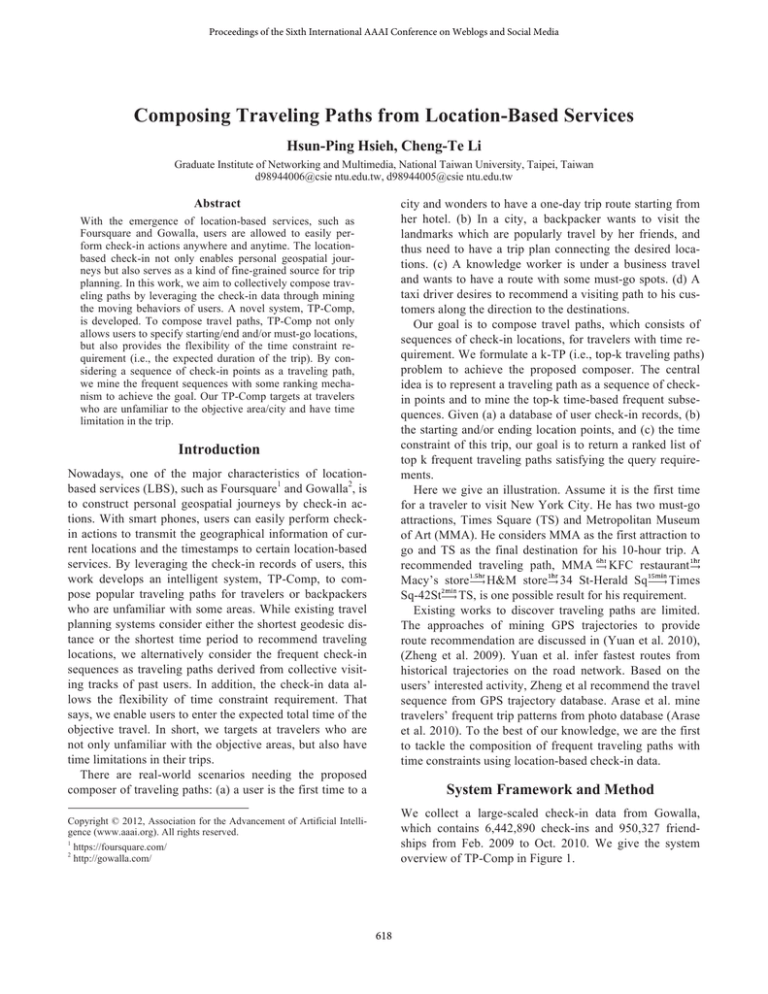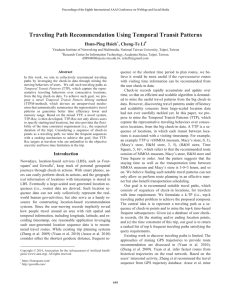
Proceedings of the Sixth International AAAI Conference on Weblogs and Social Media
Composing Traveling Paths from Location-Based Services
Hsun-Ping Hsieh, Cheng-Te Li
Graduate Institute of Networking and Multimedia, National Taiwan University, Taipei, Taiwan
d98944006@csie ntu.edu.tw, d98944005@csie ntu.edu.tw
Abstract
city and wonders to have a one-day trip route starting from
her hotel. (b) In a city, a backpacker wants to visit the
landmarks which are popularly travel by her friends, and
thus need to have a trip plan connecting the desired locations. (c) A knowledge worker is under a business travel
and wants to have a route with some must-go spots. (d) A
taxi driver desires to recommend a visiting path to his customers along the direction to the destinations.
Our goal is to compose travel paths, which consists of
sequences of check-in locations, for travelers with time requirement. We formulate a k-TP (i.e., top-k traveling paths)
problem to achieve the proposed composer. The central
idea is to represent a traveling path as a sequence of checkin points and to mine the top-k time-based frequent subsequences. Given (a) a database of user check-in records, (b)
the starting and/or ending location points, and (c) the time
constraint of this trip, our goal is to return a ranked list of
top k frequent traveling paths satisfying the query requirements.
Here we give an illustration. Assume it is the first time
for a traveler to visit New York City. He has two must-go
attractions, Times Square (TS) and Metropolitan Museum
of Art (MMA). He considers MMA as the first attraction to
go and TS as the final destination for his 10-hour trip. A
recommended traveling path, MMA KFC restaurant
Macy’s store H&M store 34 St-Herald Sq
Times
Sq-42St TS, is one possible result for his requirement.
Existing works to discover traveling paths are limited.
The approaches of mining GPS trajectories to provide
route recommendation are discussed in (Yuan et al. 2010),
(Zheng et al. 2009). Yuan et al. infer fastest routes from
historical trajectories on the road network. Based on the
users’ interested activity, Zheng et al recommend the travel
sequence from GPS trajectory database. Arase et al. mine
travelers’ frequent trip patterns from photo database (Arase
et al. 2010). To the best of our knowledge, we are the first
to tackle the composition of frequent traveling paths with
time constraints using location-based check-in data.
With the emergence of location-based services, such as
Foursquare and Gowalla, users are allowed to easily perform check-in actions anywhere and anytime. The locationbased check-in not only enables personal geospatial journeys but also serves as a kind of fine-grained source for trip
planning. In this work, we aim to collectively compose traveling paths by leveraging the check-in data through mining
the moving behaviors of users. A novel system, TP-Comp,
is developed. To compose travel paths, TP-Comp not only
allows users to specify starting/end and/or must-go locations,
but also provides the flexibility of the time constraint requirement (i.e., the expected duration of the trip). By considering a sequence of check-in points as a traveling path,
we mine the frequent sequences with some ranking mechanism to achieve the goal. Our TP-Comp targets at travelers
who are unfamiliar to the objective area/city and have time
limitation in the trip.
Introduction
Nowadays, one of the major characteristics of locationbased services (LBS), such as Foursquare1 and Gowalla2, is
to construct personal geospatial journeys by check-in actions. With smart phones, users can easily perform checkin actions to transmit the geographical information of current locations and the timestamps to certain location-based
services. By leveraging the check-in records of users, this
work develops an intelligent system, TP-Comp, to compose popular traveling paths for travelers or backpackers
who are unfamiliar with some areas. While existing travel
planning systems consider either the shortest geodesic distance or the shortest time period to recommend traveling
locations, we alternatively consider the frequent check-in
sequences as traveling paths derived from collective visiting tracks of past users. In addition, the check-in data allows the flexibility of time constraint requirement. That
says, we enable users to enter the expected total time of the
objective travel. In short, we targets at travelers who are
not only unfamiliar with the objective areas, but also have
time limitations in their trips.
There are real-world scenarios needing the proposed
composer of traveling paths: (a) a user is the first time to a
System Framework and Method
We collect a large-scaled check-in data from Gowalla,
which contains 6,442,890 check-ins and 950,327 friendships from Feb. 2009 to Oct. 2010. We give the system
overview of TP-Comp in Figure 1.
Copyright © 2012, Association for the Advancement of Artificial Intelligence (www.aaai.org). All rights reserved.
1
https://foursquare.com/
2
http://gowalla.com/
618
and the LB6 is the destination, we merge PA and PB to generate a new path PC = <LA1, LA2, LB4, LB5, LB6>. Besides,
we average the support values of original routes to be the
support of the merged traveling path.
To return a ranked list of top-k traveling paths, we provide three ranking criteria. The first one is the support value, which determines the popularity of mined subsequences. The second one is the time constraint. If the total time
of a mined traveling path is much shorter than time constraint, the remaining time could be wasted. We rank traveling paths based on the remaining time (the less, the better). The third one is the social effect. Users may prefer
those mined subsequences that had ever visited by their
friends. Therefore, for a mined traveling path, if the sum of
visit times for its locations is larger, it will tend to have a
higher rank. Such three ranking criteria can be combined to
have better quality of traveling paths.
Preprocessing. For each user, we transform his checkin records into sequences of locations. We also associate
the time span between two consecutive locations by averaging the time duration between two check-in places for all
people. A database of traveling paths is then built.
System Interface
The system interface of TP-Comp is shown in Figure 2.
Travelers are allowed to input some desired locations or
choose popular attractions we suggest, as well as the expected travel time duration. The generation top-k traveling
paths are shown in the right panel. If the traveler has
Gowalla ID, the system can use his own social circle to derive the results. Furthermore, TP-Comp can also recommend the transportation mode between locations, which is
developed by integrating with Google Map API.
Figure 1. System Overview.
Frequent Subsequence Mining. The goal is to mine
frequent subsequence from the database of traveling paths.
For a query containing some locations with a time constraint, our TP-Comp system first retrieves the sequences
with query locations. Then we devise a frequent subsequence mining method to find the frequent paths of locations. We measure the importance of a subsequence by calculating its support value, which is the number of sequence
containing such subsequence. A subsequence P is frequent
if its support is not less than minsup, where minsup is a user-specified minimum support threshold. In our system, we
prefer to set minsup = 1% to ensure that the system contains enough traveling paths. We adopt similar concepts
from (Wang et al. 2007) to mine the frequent subsequence.
The mining process is recursively performed in a depthfirst search manner until no more frequent subsequences
can be found.
Since we aim to compose the traveling paths based on
the query starting and/or ending locations, the mined subsequences can be further pruned accordingly. Besides, we
also remove subsequences violating the time constraint. A
subsequence is ruled out if its total traveling time exceeds
the time constraint specified by the traveler.
Since the number of query locations could be larger than
the length of mined traveling paths, we might need to
merge the two or more separate subsequences to obtain
traveling paths satisfying query requirements. We merge
two traveling paths if they share at least one location. Here
we use an example to elaborate the idea. Assuming that
there are two frequent subsequences, PA = <LA1, LA2, LA3,
LA4> and PB = <LB1, LB2, LB3, LB4, LB5, LB6>, are mined,
where LA2= LB3. If the location LA1 is the starting location,
Figure 2. The interface of TP-Comp system.
References
Arase,Y., Xie, X., Hara, T., and Nishio, S.. Mining people’s trips
from large scale geo-tagged photos. In ACM MM, pages 133142, 2010.
Chen, Z., Shen, H. T., and Zhou, X.. Discovering popular routes
from trajectories. In ICDE, pages 900-911, 2011.
Wang J., Han J., and Li C. Frequent closed sequence mining
without candidate maintenance. IEEE Transactions on
Knowledge and Data Engineering TKDE, 19(8), 2007.
Yuan, J., Zheng, Y., Zhang, C., Xie, W., Xie, X., Sun, G., and
Huang, Y.. T-drive: driving directions based on taxi trajectories.
In ACM GIS, pages 99-108, 2010.
Zheng, Y., Zhang, L., Xie X, and Ma, W.-Y. Mining interesting
locations and travel sequences from GPS trajectories. In WWW,
pages 791-800, 2009.
619



